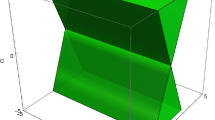Abstract
We consider the Hamiltonian function defined by the cubic polynomial \(H= \frac{1}{2}(y_1^2+ y_2^2)+ V(x_1, x_2)\) where the potential \(V(x)= \delta V_2(x_1, x_2)+ V_3(x_1, x_2)\), with \(V_2(x_1, x_2)=\frac{1}{2}(x_1^2+x_2^2)\) and \( V_3(x_1, x_2)= \frac{1}{3} x_1^3+ f x_1 x_2^2+ g x_2^3\), with f and g are real parameters such that \(f \ne 0\) and \(\delta \) is 0 or 1. Our objective is to study the number and bifurcations of the equilibria and its type of stability. Moreover, we obtain the existence of periodic solutions close to some equilibrium points and an isolated symmetric periodic solution distant of the equilibria for some convenient region of the parameters. We point out the role of the parameters and the difference between the homogeneous potential case (\(\delta = 0\)) and the general case (\(\delta = 1\)).







Similar content being viewed by others
References
Churchill, R.C., Pecelli, G., Rod, D.L.: Isolated unstable periodic orbits. J. Differ. Equ. 173, 329–348 (1975)
Churchill, R.C., Pecelli, G., Rod, D.L.: A survey of the Hénon–Heiles Hamiltonian with application to related examples. Lecture Notes in Physics, Stochastic Behavior in Classical and Quantum Hamiltonian Systems 93, 76–136 (1979)
Falconi, M., Lacomba, E.A.: Asymptotic behavior of escape solutions of mechanical systems with homogeneous potentials. Contemp. Math. 198, 181–195 (1996)
Falconi, M., Lacomba, E.A., Vidal, C.: Global dynamics of mechanical systems with cubic potentials. Qual. Theory Dyn. Syst. 2, 429–453 (2001)
Falconi, M., Lacomba, E.A., Vidal, C.: The flow of classical mechanical cubic potential system. Discret. Contin. Dyn. Syst. 11(4), 827–842 (2004)
Iñarrea, M., Lanchares, V., Palacián, J.F., Pascual, A.I., Salas, J.P., Yanguas, P.: Lyapunov stability for a generalized Hénon–Heiles system in a rotating reference frame. Appl. Math. Comput. 253, 159–171 (2015)
Llibre, J., Simó, C.: On the Hénon-Heiles potential, III Congreso de Ecuaciones Diferenciales y Aplicaciones, U. de Santiago de Compostela, 183–206 (1981)
Maciejewski, A.J., Przybylska, M.: All meromorphically integrable 2D Hamiltonian systems with homogeneous potentials of degree 3. Phys. Lett. A 327, 461–473 (2004)
Meyer, K.R., Hall, G.R.: Introduction to Hamiltonian Dynamical System and the N-Body Problem. Springer-Verlag, New York (1992)
Moser, J.: Periodic orbits near an equilibrium and a theorem of A. Weinstein. Commun. Pure Appl. Math. 29, 727–747 (1976)
Rod, D.L.: Phatology of invariant sets in the Monkey Saddle. J. Differ. Equ. 14, 129–170 (1973)
Siegel, C., Moser, J.: Lectures on Celestial Mechanics. Springer, New York (1971)
Sokol’skii, A.G.: On the stability of self-contained Hamiltonian systems with two degrees of freedom in the case of zero frequencies. J. Appl. Math. Mech. 45(3), 441–449 (1981)
Acknowledgements
We thank to the reviewer his/her comments and suggestions calling attention in important points which help us to improve this paper. Claudio Vidal was partially supported by project Fondecyt 1180288.
Author information
Authors and Affiliations
Corresponding author
Appendix
Appendix
1.1 The Lyapunov Center Theorem and Moser’s Theorem
Theorem 5
Assume that the system
admits a nondegenerate integral and has an equilibrium point with exponents \(\pm i \omega \), \(\lambda _3, \ldots , \lambda _n\), where \(i \omega \ne 0\) is pure imaginary. If \(\frac{\lambda _j}{i \omega }\) is never an integer for \(j+3, \ldots , n\), then there exists a one-parameter family of periodic orbits emanating from the equilibrium point. Moreover, when approaching the equilibrium point along the family, the periods tend to \(2 \pi / \omega \) and the nontrivial multipliers tend to \(e^{2 \pi \lambda _j/ \omega }\), \(j=3, \ldots , m\).
The proof of this theorem can be found in [9].
Remark 1
When the system (5.1) is an Hamiltonian system then it has always a nondegenerate integral.
Now, we will enunciate Moser’s Theorem (see details in [10]) which is a generalization of Lyapunov’s Theorem.
Theorem 6
Consider a Hamiltonian system
such that \(\nabla H(0)=0\). Assume that \({\mathbb {R}}^ {2n}= E + F\) where E, F are invariant subspaces of A where \(A= J Hess H(0)\) (the linear part around the equilibrium 0), such that all solutions of this linear system in E have the same period \(T>0\) while no nontrivial solution in F has this period. Moreover, assume that the Hessian HessH(0) restricted to E is positive definite. Then, for sufficiently small \(\epsilon \), on each energy surface \(H(z)= H(0)+ \epsilon ^2\) the number of periodic orbits of this system is at least \(1/2\, dim(E)\).
1.2 Isolated Periodic Solution
Here we will only enunciate Theorem 1.1 of [1], the details of the notation can be found there.
It is considered the mechanical systems
Both W and the region will have an axis of symmetry \({\mathcal {A}}\) which will contain the only critical point P of W in this region. The symmetry allows us to restrict our consideration to the ”upper” half-plane defined by \({\mathcal {A}}\). An energy h will be chosen so that the level curve \(W(x)= h\) lies above and does not intersect \({\mathcal {A}}\). Note that by symmetry \({\mathcal {A}}\) is a gradient line (homothetic solution). We construct a closed, simply connected region R between \(W = h\) and \({\mathcal {A}}\) by first specifying two such solutions that intersect \({\mathcal {A}}\) at points \(Q_1\) and \(Q_2\), respectively, where \(Q_1\) is strictly to the left of P and \(Q_2\) is to the right of P (\(Q= P\) is allowed). We then obtain R by intersecting this region by a vertical strip whose right-hand boundary is a line perpendicular to \({\mathcal {A}}\) at P.
Theorem 7
(a) the orbit segment \(x_q(t)\) in R for points on \(W=h\) foliates R; (b) for \(q< p\) (\(p< q\)) any orbit \(x_q(t)\) that intersects A does so in an acute (obtuse) angle.
Then there is a periodic orbit \(\Pi \), unstable and it is the only solution of \({\ddot{x}}=- W_x\) with energy h that remains in \(R \cup {\bar{R}}\) for all time.
In [1] it is shown that instead of proving conditions (a) and (b) in Theorem 7, the hypotheses (H1)–(H5) can be proved which imply (a) and (b).
-
(H1)
The gradient field W, restricted to \({\mathcal {A}}\) in \(R {\setminus }\{P\}\) points towards P, and above \({\mathcal {A}}\) in R has values in the upper half-plane defined by \({\mathcal {A}}\).
-
(H2)
\(div\left( \frac{J W_x}{\Vert J W_x\Vert }\right) > 0\) in the interior of R, or equivalently, the gradient field \(W_x\) rotates counterclockwise along gradient curves [in the direction \(W_x\)) in this region.
-
(H3)
The level curve \(W(X)=h_0\), where \(h_0= W(P)\) is the critical energy, is a straight line issuing from P that bisects the region \({\mathcal {A}}\). For energies \(h > h_0\), the level curves \(W = h\) lie above \(W = h_0\), and are concave up with respect to the axis of symmetry. For \(h < h_0\), the level curves \(W = h\) lie below \(W = h_0\), and are concave down with respect to the axis of symmetry.
-
(H4)
All orbits x(t) of (5.3), with energy \(h > h_0\), which originate on \(W = h\) and enter the subregion of \(R {\setminus }\{P\}\) between and including the lines \({\mathcal {A}}\) and \(W = h\) intersect the T-curves in this region transversely. Let \(T= - J W_{xx} J W_x\). The integral curves of the vector field T are called T-curves.
-
(H5)
Consider any T-curve in the subregion of \(R {\setminus } \{P\}\) between \({\mathcal {A}}\) and \(W = h_0\), including \({\mathcal {A}}\) and \(W = h_0\). For any vector u obtained as the unit tangent vector of an orbit of energy h rising to \(W = h\), as it crosses this T-curve, \(\langle T, J u\rangle (x) >0\) and \(T(G_u(x)) < 0\), for all x on this T-curve between the point of intersection and P. Here \(G_u(x)= \left( \frac{\langle W_x, J u\rangle [e_1(W)]^2}{2(h- W) \langle T, J u\rangle }\right) (x)\). \(e_1\) denote a constant unit vector field which, when restricted to the axis of symmetry \({\mathcal {A}}\) to the left of P, points towards the critical point and \(e_2= -J e_1\).
Remark 2
From hypothesis (H1)–(H3) it is easy to show that, at points to the left of M and on \(M {\setminus }\{q\}\) in R, the acceleration field \(-\nabla W(x)\) points to the left of M.
When the potential function W in (5.3) is an homogeneous function of degree n it was proved in [1] the following result in Corollary 4.2.
Corollary 1
Assume that the region R satisfies the previous requirement. Let \(\nabla W \ne 0\) and \(\lambda = det Hess(W) < 0\) in \(R {\setminus } \{0\}\). If hypothesis (H1) holds and there is no gradient line of the potential W in the interior of R, then hypotheses (H2)–(H5) hold.
Rights and permissions
About this article
Cite this article
Carrasco-Olivera, D., Vidal, C. Dynamics and Periodic Solutions in Cubic Polynomial Hamiltonian Systems. Qual. Theory Dyn. Syst. 18, 383–403 (2019). https://doi.org/10.1007/s12346-018-0291-2
Received:
Accepted:
Published:
Issue Date:
DOI: https://doi.org/10.1007/s12346-018-0291-2
Keywords
- Hamiltonian polynomial vector fields
- Mechanical systems
- Equilibrium points
- Stability
- Homothetic solution
- Isolated periodic solution




